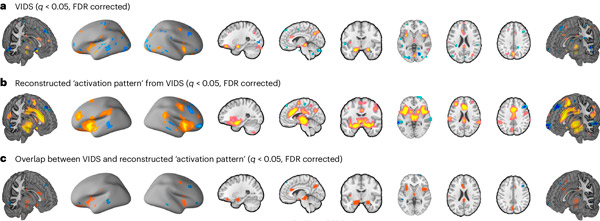Nye publikasjoner
Det nevrale sporet av avsky manifesterer seg i sensoriske og moralske opplevelser
Sist anmeldt: 02.07.2025

Alt iLive-innhold blir gjennomgått med medisin eller faktisk kontrollert for å sikre så mye faktuell nøyaktighet som mulig.
Vi har strenge retningslinjer for innkjøp og kun kobling til anerkjente medieområder, akademiske forskningsinstitusjoner og, når det er mulig, medisinsk peer-evaluerte studier. Merk at tallene i parenteser ([1], [2], etc.) er klikkbare koblinger til disse studiene.
Hvis du føler at noe av innholdet vårt er unøyaktig, utdatert eller ellers tvilsomt, velg det og trykk Ctrl + Enter.

Avsky er en av de seks grunnleggende menneskelige følelsene, sammen med lykke, tristhet, frykt, sinne og overraskelse. Avsky oppstår vanligvis når en person oppfatter en sensorisk stimulus eller situasjon som frastøtende, ubehagelig eller på annen måte motbydelig.
Tidligere psykologisk forskning har definert avsky som en unngående-forsvarsfølelse, og assosiert den med visse ansiktsuttrykk, bevegelser og fysiologiske responser. Selv om avsky primært er assosiert med ubehagelig matsmak, ubehagelig lukt eller synet av frastøtende bilder, kan det også oppstå som respons på andre stimuli, inkludert ubehagelige sosiale interaksjoner.
Forskere fra University of Electronic Science and Technology of China og andre institusjoner gjennomførte nylig en studie som hadde som mål å bedre forstå de nevrale grunnlagene for avsky og dens generalisering til kontekster utover matinntak. Funnene deres, publisert i tidsskriftet Nature Human Behavior, tyder på at den nevrofunksjonelle signaturen til subjektiv avsky er den samme for oral avsky og ubehagelige sosiomoralske opplevelser.
«Selv om avsky stammer fra den hardkablede pattedyr-aversjonsresponsen, er den bevisste opplevelsen av avsky hos mennesker svært avhengig av subjektiv vurdering og kan til og med strekke seg til sosiomoralske kontekster», skriver Xianyang Gang, Feng Zhou og kolleger i sin artikkel.
«I en serie studier kombinerte vi funksjonell magnetisk resonansavbildning (fMRI) med maskinlæringsbasert prediktiv modellering for å lage en omfattende nevrobiologisk modell av subjektiv avsky.»

Subjektiv avsky er assosiert med og predikert av distribuerte hjerneområder. a, VIDS-terskelkart. b, VIDS-terskeltransformert 'aktiverings'-kart. c, Overlegg av VIDS og transformert 'aktiverings'-kart. Bilder terskelsatt ved q < 0,05, FDR-korrigert. Varme farger indikerer positive vekter (a) eller assosiasjoner (b), kalde farger indikerer negative vekter (a) eller assosiasjoner (b). Kilde: Nature Human Behaviour (2024). DOI: 10.1038/s41562-024-01868-x
Deltakerne i eksperimentet ble vist forskjellige bilder som var utformet for å fremkalle følelser av avsky, og de ble bedt om å reagere naturlig på disse bildene. Etter å ha sett hvert bilde, ble deltakerne bedt om å vurdere nivået av avsky på en skala fra 1 (liten/ingen avsky) til 5 (sterk avsky).
Ved å overvåke deltakernes hjerneaktivitet ved hjelp av fMRI og analysere de innsamlede dataene ved hjelp av en maskinlæringsmodell, var forskerne i stand til å avgrense en nevral signatur assosiert med subjektive oppfatninger av avsky. Denne signaturen forutså nøyaktig deltakernes selvrapporterte avsky, og generaliserte godt til baseline-avsky, smaksavsky og sosiomoralske reaksjoner på urettferdige tilbud i et spill.
«Avskyopplevelser ble kodet i distribuerte kortikale og subkortikale systemer og viste særegne og delte nevrale representasjoner med subjektiv frykt eller negativ affekt i de interoceptive-emosjonelle bevissthets- og bevisste vurderingssystemene, mens signaturer mest nøyaktig forutså den tilsvarende målopplevelsen», skrev Gan, Zhou og kolleger i sin artikkel.
"Vi tilbyr en presis funksjonell magnetisk resonansavbildningssignatur av avsky med stort potensial for å løse pågående evolusjonære kontroverser."
En nylig studie av Gan, Zhou og medforfatterne deres beskrev et aktivitetsmønster i hjernen assosiert med subjektive opplevelser av avsky. Mer spesifikt ble subjektiv avsky kodet samtidig i flere hjerneområder, snarere enn i atskilte regioner.
Interessant nok observerte forskerne den samme nevrale signaturen over hele hjernen i en rekke situasjoner der folk opplever avsky, fra å smake på ubehagelig mat til å føle empati med andre som har vondt eller motta et urettferdig tilbud. Disse funnene kan snart bane vei for videre nevrovitenskapelig forskning fokusert på den nevrofunksjonelle signaturen til avsky, noe som potensielt kan føre til spennende nye oppdagelser.
